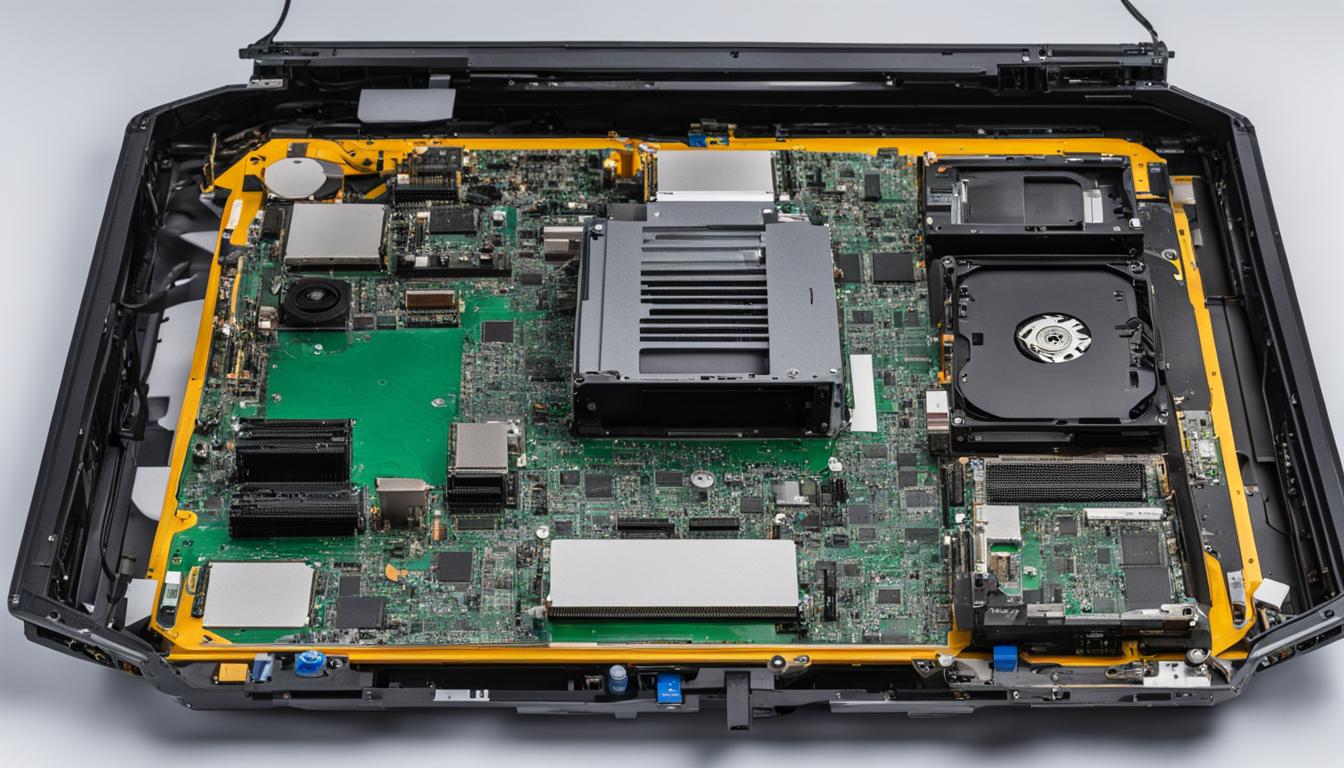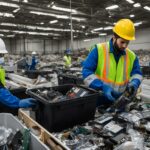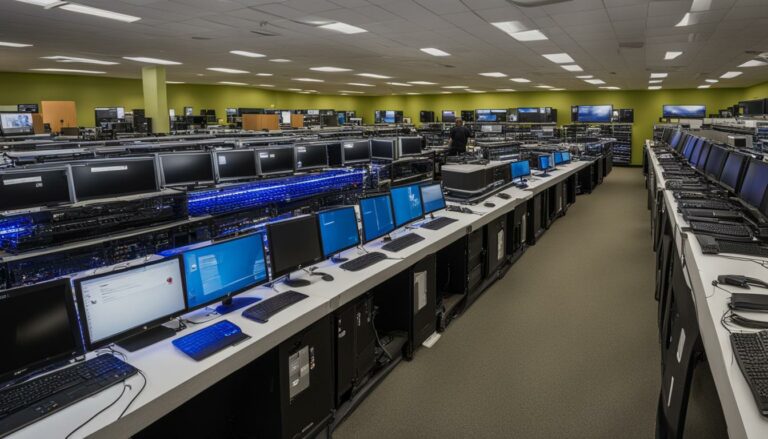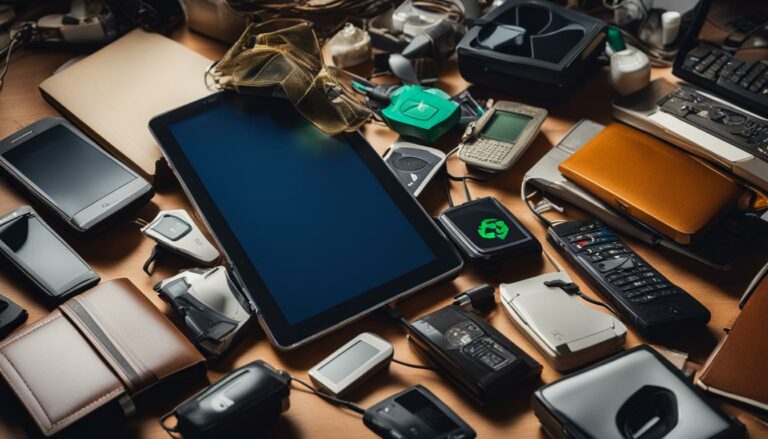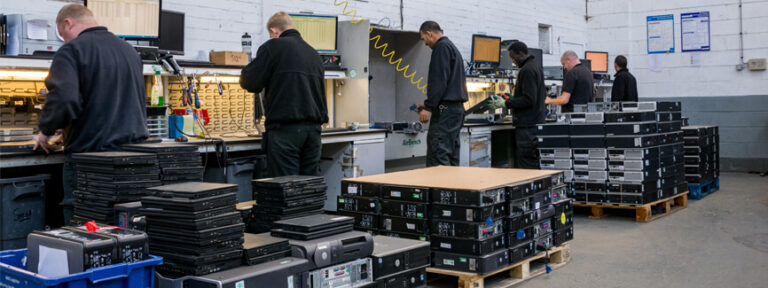From User to Recycler: The Lifecycle of a Computer
Computers play a significant role in our daily lives, from work to entertainment. However, have you ever thought about what happens to a computer throughout its lifecycle? The process, from mining the raw materials to disposal and recycling, can have a substantial impact on the environment. In this article, we will delve into the various stages of a computer’s lifecycle, highlighting the importance of sustainable computing in the UK.
Key Takeaways:
- The lifecycle of a computer involves mining, manufacturing, transportation, usage, and end-of-life management.
- Reducing the environmental impact of computers requires sustainable material selection, energy-efficient usage, and responsible recycling.
- Buying EPEAT registered products promotes responsible material selection and end-of-life management.
- Transportation and electricity usage during the computer’s lifespan contribute to CO2 emissions and energy consumption.
- End-of-life management involves recycling, donation, or repurposing to conserve resources and avoid hazardous waste in landfills.
Mining and Material Selection
A computer is composed of more than 30 different minerals that are mined and extracted from the earth. These minerals include silica, iron, aluminum, copper, lead, zinc, and more. The mining process involves extracting minerals from the ground, which can have a significant impact on the environment. It disrupts ecosystems, leads to soil erosion, and contributes to water pollution. Additionally, mining operations often consume large amounts of energy and generate greenhouse gas emissions.
The Impact of Mining
“Mining activities have a profound environmental impact, from habitat destruction and water contamination to air pollution and climate change. It is essential to address these challenges and promote responsible mining practices.”
One way to mitigate the environmental impact of mining is through responsible material selection. When purchasing computers, it is advisable to choose products that are registered with the Electronic Product Environmental Assessment Tool (EPEAT) program. EPEAT registered products adhere to specific criteria that promote sustainability, including the use of environmentally preferable materials and responsible end-of-life management. By supporting EPEAT, consumers can encourage manufacturers to prioritize sustainable material sourcing and reduce the ecological footprint of computer production.
| Environmental Impact of Mining | Solutions |
|---|---|
| Habitat destruction | Responsible material selection |
| Water contamination | Supporting EPEAT registered products |
| Air pollution | Promoting responsible mining practices |
| Climate change |
“The environmental impact of mining can be mitigated through responsible material selection and supporting initiatives like the EPEAT program. By making conscious choices, we contribute to a more sustainable computer lifecycle.”
Manufacturing and Packaging
Once the raw materials have been extracted, they undergo a series of manufacturing processes to transform them into computer parts. This stage is highly energy-intensive and involves shipping materials to manufacturing plants worldwide. The manufacturing process itself requires significant energy consumption, contributing to the overall environmental impact of computers. In addition to energy consumption, the manufacturing stage also generates waste and emissions that further impact the environment.
Manufacturers use various materials for packaging computers to ensure their safe transportation. Typical packaging materials include plastic, styrofoam, and cardboard, which are commonly used due to their durability and protective properties. However, the disposal of packaging materials poses environmental challenges, as they often end up in landfills, contributing to waste accumulation. Addressing the environmental impact of packaging requires innovative solutions that prioritize recyclable and biodegradable materials, as well as reducing the overall volume of packaging used.
The Environmental Impact of Manufacturing and Packaging
“The manufacturing and packaging stages of the computer lifecycle consume significant energy and generate waste and emissions, contributing to the overall environmental impact. Addressing the environmental challenges associated with these stages requires sustainable material choices and innovative packaging solutions.”
Reducing the environmental impact of manufacturing and packaging requires a multi-faceted approach. Manufacturers can adopt sustainable practices by optimizing manufacturing processes to reduce energy consumption and waste generation. Investing in clean energy sources and implementing energy-efficient technologies can significantly reduce the carbon footprint of manufacturing operations. Additionally, manufacturers can explore alternative packaging materials that are more environmentally friendly, such as biodegradable or recyclable options.
| Environmental Impact of Manufacturing and Packaging | Sustainable Solutions |
|---|---|
| High energy consumption | Optimize manufacturing processes, invest in clean energy sources |
| Waste generation | Implement waste reduction measures, promote recycling |
| Emissions | Adopt energy-efficient technologies, reduce carbon footprint |
| Disposal of packaging materials | Explore biodegradable and recyclable packaging options |
By prioritizing sustainable manufacturing practices and eco-friendly packaging solutions, the environmental impact of the manufacturing and packaging stages can be minimized. Collaboration between manufacturers, policymakers, and consumers is essential for driving positive change and promoting a more sustainable computer lifecycle.
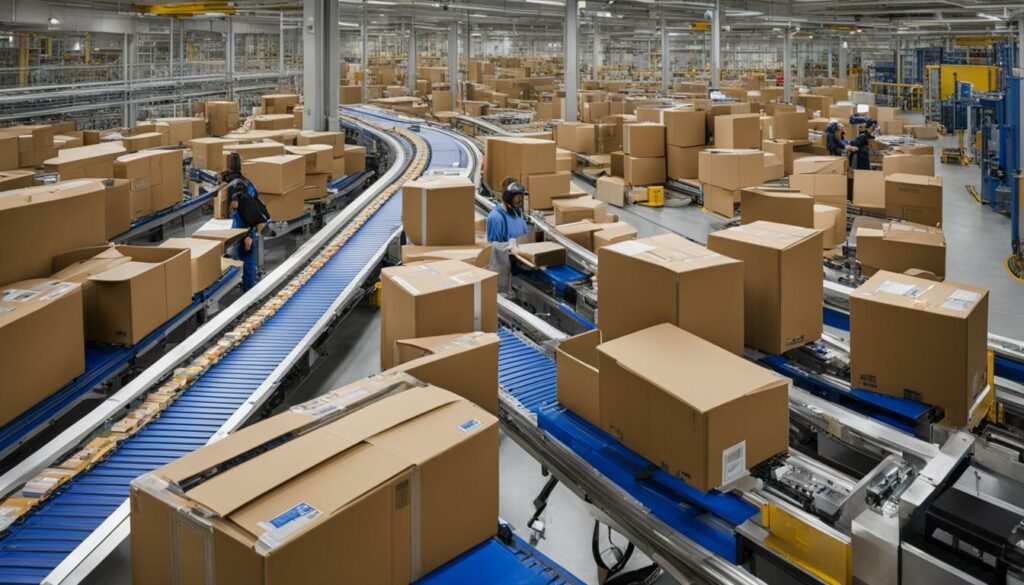
Transportation and Usage
Transportation and usage play a significant role in the lifecycle of a computer, impacting both the environment and energy consumption. When it comes to transportation, computers are often shipped long distances, relying heavily on fossil fuels and contributing to CO2 emissions. This transportation process can be optimized to reduce its environmental impact, such as by choosing more energy-efficient shipping methods and consolidating shipments whenever possible.
Once computers reach their destination, they require electricity to function. This electricity is typically generated from sources such as coal, petroleum, or natural gas, which further contributes to greenhouse gas emissions. To minimize the environmental impact of computer usage, adopting power-saving settings and investing in energy-efficient products is crucial. These measures can help reduce electricity consumption and lower carbon footprints.
It is also worth mentioning that the growing shift towards cloud computing has the potential to decrease the need for individual physical computer units. By utilizing shared resources in data centers, cloud computing can lead to more efficient energy use and reduced transportation requirements. However, it is important to consider the energy consumption of data centers and ensure they are powered by renewable sources to fully harness the environmental benefits.
Key Considerations for Sustainable Transportation and Usage:
- Choose energy-efficient shipping methods and consolidate shipments to minimize the carbon footprint of computer transportation.
- Adopt power-saving settings and invest in energy-efficient products to reduce electricity consumption during computer usage.
- Explore the potential benefits of cloud computing, which can decrease the need for individual physical computer units.
- Ensure data centers powering cloud computing services are powered by renewable energy sources.
Table: Energy Consumption by Computer Usage
| Computer Usage | Energy Consumption |
|---|---|
| Standard Desktop Usage | 100-150 watts per hour |
| Laptop Usage | 50-75 watts per hour |
| Standby Mode | 1-5 watts per hour |
| Power Saving Mode | 1-3 watts per hour |
End-of-Life Management
Responsible end-of-life management is a critical aspect of the computer lifecycle that greatly impacts the environment. When a computer reaches the end of its life, it should be properly recycled, donated, or repurposed to minimize waste and maximize resource conservation. Recycling old computers helps reduce the energy and resources required to manufacture new ones, making it an important step towards sustainability.
Proper disposal of electronic devices is crucial to ensure data deletion and prevent hazardous chemicals from entering landfills. Electronics contain components that can be harmful to the environment if not managed correctly. By disposing of old computers in an environmentally friendly way, we can contribute to a cleaner and healthier future.
Benefits of Recycling Computers
Recycling computers offers numerous benefits, both for the environment and the economy. Here are a few key advantages:
- Resource Conservation: Recycling helps conserve valuable resources such as minerals, metals, and plastics, reducing the need for extensive mining and extraction.
- Energy Savings: The recycling process requires less energy compared to manufacturing new computers from scratch, leading to significant energy savings.
- Reduced E-Waste: Electronic waste, or e-waste, is a growing concern worldwide. Recycling computers helps divert e-waste from landfills, where toxic substances can leach into the soil and water.
- Job Creation: The recycling industry creates employment opportunities, contributing to economic growth and local development.
Proper Disposal Methods
When disposing of a computer, it’s important to follow proper procedures to ensure responsible recycling. Here are a few disposal methods to consider:
- Recycling Programs: Many companies and organizations have recycling programs specifically designed for electronic devices. They provide convenient drop-off locations or collection services to ensure computers are recycled in an environmentally friendly manner.
- Donation: If your computer is still functional, consider donating it to schools, non-profit organizations, or individuals in need. This can extend the lifespan of the device and benefit others who may not have access to technology.
- Trade-in or Buyback Programs: Some computer manufacturers and retailers offer trade-in or buyback programs, allowing you to exchange your old device for a discount on a new one. These programs often include responsible recycling of the traded-in devices.
By choosing the right disposal method and participating in recycling initiatives, we can all play a part in minimizing the environmental impact of computers and promoting a more sustainable future.
IT Procurement and Lifecycle Services
When it comes to the computer lifecycle, businesses need to carefully navigate the process of IT procurement. This involves selecting the right hardware and financing options to meet their specific needs. One cost-efficient solution is renting or leasing hardware, which allows companies to stay up-to-date with the latest technology without a significant upfront investment. By choosing this option, businesses can minimize their financial risk and adapt to changing requirements more easily.
Maintenance services also play a crucial role in ensuring the smooth operation of IT hardware. Proactive maintenance, regular updates, and quick repairs or replacements are vital to avoid costly downtime. By partnering with experienced providers, businesses can benefit from expert support and maximize the lifespan of their equipment. This not only reduces the need for premature replacements but also contributes to a more sustainable approach to IT.
“Renting or leasing hardware allows companies to stay up-to-date with the latest technology without a significant upfront investment.”
Disposal and responsible recycling are key considerations when the lifecycle of IT hardware comes to an end. Proper disposal ensures data deletion and prevents sensitive information from falling into the wrong hands. Moreover, it helps avoid significant environmental harm caused by hazardous materials found in electronic devices. Businesses should opt for recycling programs that adhere to regulatory requirements and prioritize the extraction and reuse of valuable resources.
| Pros | Cons | |
|---|---|---|
| Renting/Leasing | – Lower upfront costs – Flexibility to upgrade – Regular maintenance and support |
– Long-term cost may be higher – Limited customization options |
| Purchasing | – Full ownership – Customization options |
– Higher upfront costs – Increased responsibility for maintenance and disposal |
The table above provides a quick comparison between renting/leasing and purchasing IT hardware. While each option has its own advantages and disadvantages, it is important for businesses to evaluate their specific needs, budget, and long-term goals to make an informed decision.
By carefully considering IT procurement, maintenance, and disposal practices, businesses can contribute to a more sustainable approach to the computer lifecycle. Making responsible choices not only benefits the environment, but also helps businesses optimize their resources and streamline operations.
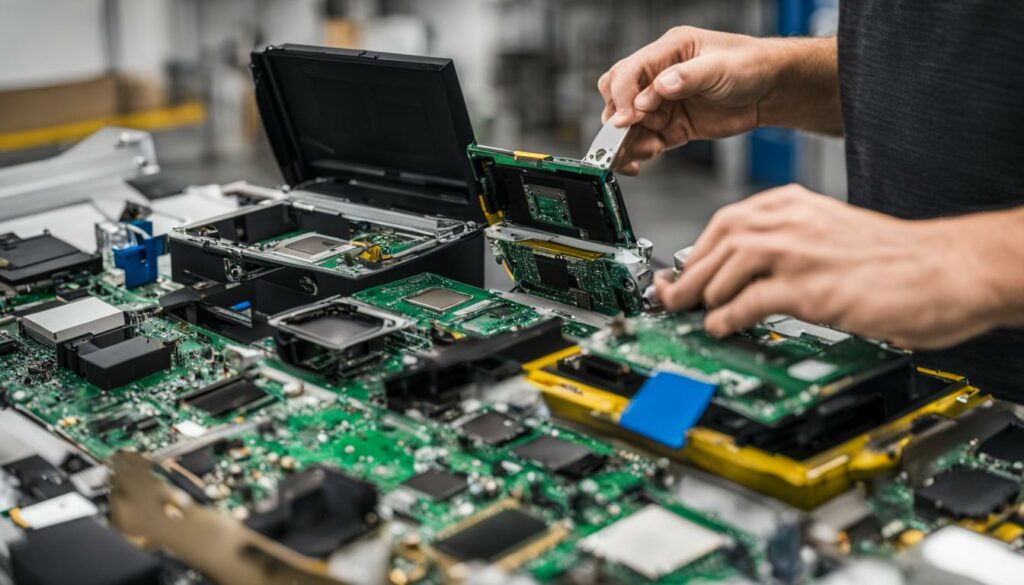
Conclusion
The lifecycle of a computer involves multiple stages, including mining, manufacturing, usage, and end-of-life management. Each of these stages contributes to the environmental impact of computers. It is imperative that we practice sustainable computing and responsible recycling to mitigate the negative effects.
By adopting sustainable computing practices, such as reducing electricity usage through power-saving settings and investing in energy-efficient products, we can significantly decrease the energy consumption of computers. This not only helps conserve valuable resources but also minimizes the carbon footprint associated with electricity generation.
Responsible recycling is another crucial aspect of the computer lifecycle. When a computer reaches the end of its life, it should be properly recycled, donated, or repurposed. Recycling not only reduces the demand for new resources but also helps prevent hazardous materials from ending up in landfills.
By making informed choices at every stage of the computer lifecycle, we can work towards a more sustainable future. Through sustainable computing practices and responsible recycling, we can minimize waste, conserve resources, and reduce the environmental impact of computers.
FAQ
What is the environmental impact of the computer lifecycle?
The computer lifecycle involves various stages that contribute to its environmental impact, including mining, manufacturing, transportation, usage, and end-of-life management.
How does the mining process affect the environment?
The mining process involves extracting nonrenewable resources from the earth, including minerals like silica, iron, aluminum, copper, lead, and zinc. It is important to use these resources sustainably.
What is the role of EPEAT registered products in sustainable material selection?
Buying EPEAT registered products encourages responsible material selection, life cycle extension, and end-of-life management, reducing the environmental impact of computers.
How does manufacturing and packaging contribute to the environmental impact?
The manufacturing process is energy-intensive and involves shipping materials worldwide. Once manufactured, computers are packaged using materials like plastic, styrofoam, and cardboard.
What are the environmental implications of transportation and electricity usage in the usage phase?
Computers are often shipped long distances, relying on fossil fuels and contributing to CO2 emissions. In the usage phase, computers require electricity, which may come from coal, petroleum, or natural gas.
What is responsible end-of-life management for computers?
Responsible end-of-life management involves recycling, donating, or repurposing old computers to reduce energy and resource consumption. Proper disposal ensures data deletion and avoids hazardous chemicals in landfills.
What are the considerations for IT procurement and lifecycle services?
IT procurement involves selecting the right hardware and financing options, while maintenance services ensure trouble-free operation. When the lifecycle of IT hardware ends, responsible disposal and recycling options are available to avoid legal problems and environmental harm.
How can sustainable computing and responsible recycling help the environment?
By practicing sustainable computing and responsible recycling, we can reduce energy consumption, conserve resources, minimize waste, and create a more sustainable future for the environment.

